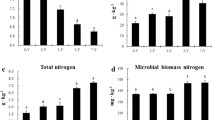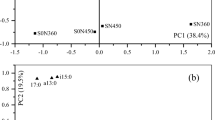Abstract
Soil degradation has led crop yield to decline in many Sahelian countries and is a fundamental agricultural and economical threat for local populations. In Saria, Burkina Faso, long-term experiments are being performed to find efficient soil management practices that could improve soil fertility. A randomized block experiment comprising organic amendment (unamended control, straw at 8.3 t ha−1, manure at 10 t ha−1) coupled with mineral fertilization (no urea, urea at 60 kg ha−1) was started in 1980 with a continuous sorghum (Sorghum bicolor) cropping system. Twenty-six years after the settlement of the treatments, we compared their effects on nematode populations, community structure, and ecological indices, as well as soil physical and chemical properties at three stages of sorghum’s cropping cycle.
The addition of manure led to significantly higher soil C, N, and P content and produced a higher sorghum grain yield in comparison to unamended or straw-amended soils. The number of plant-parasitic nematodes (mainly Pratylenchus and Tylenchorhynchus) was significantly higher in plots fertilized with manure in comparison to unamended or straw-amended plots. They were also significantly more abundant when urea was added. Mineral nitrogen fertilization had little impact on free-living nematodes, regardless of S. bicolor development stage, whereas organic amendment significantly raised the abundance of bacterivorous and fungivorous nematodes. Moreover, microphagous nematodes were significantly more numerous in plots amended with straw than with manure. Our results show that, on the long-term, only manure amendment seemed able both to store C and nutrients whereas both manure and straw led to greater microphagous nematode communities.


Similar content being viewed by others
References
Anderson MJ (2001) A new method for non-parametric multivariate analysis of variance. Aust Ecol 26:32–46
Anderson MJ, Gorley RN, Clarke KR (2008) PERMANOVA+for PRIMER. Guide to software and statistical methods, Plymouth
Bardgett RD, Cook R, Yeates GW, Denton CS (1999) The influence of nematodes on below-ground processes in grassland ecosystems. Plant Soil 212:23–33
Berkelmans R, Ferris H, Tenuta M, van Bruggen AHC (2003) Effects of long-term crop management on nematode trophic levels other than plant feeders disappear after 1 year of disruptive soil management. Appl Soil Ecol 23:223–235
Blanchart E, Villenave C, Viallatoux A, Barthès B, Girardin C, Azontonde A, Feller C (2006) Effect of a cover plant (Mucuna pruriens var. utilis) on the communities of soil macrofauna and nematofauna, under maize cultivation, in South Benin. Eur J Soil Biol 42:136–144
Bongers T (1990) The maturity index: an ecological measure of environmental disturbance based on nematode species composition. Oecologia 83:14–19
Bulluck LR, Barker KR, Ristaino JB (2002) Influences of organic and synthetic soil fertility amendments on nematode trophic groups and community dynamics under tomatoes. Appl Soil Ecol 21:233–250
Coleman D, Oades JM, Uehara G (1989) Dynamics of soil organic matter in tropical ecosystems. University of Hawaii Press, Hawaii
Dabin B (1967) Application des dosages automatiques à l’analyse des sols. 3ème partie. Cahiers ORSTOM. Sér Pédologie 5:257–286
Djigal D, Brauman A, Diop A, Chotte J-L, Villenave C (2004) Influence of some bacterial-feeding nematodes (Cephalobidae) on soil microbial community during mays growth. Soil Biol Biochem 36:323–331
Ekelund F, Saj S, Vestergård M, Bertaux J, Mikola J (2009) The “soil microbial loop” is not always needed to explain protozoan stimulation of plants. Soil Biol Biochem 41:2336–2342
Ettema CH, Bongers T (1993) Characterization of nematode colonisation and succession in disturbed soil using the maturity index. Biol Fertil Soils 16:79–85
FAO (1995) Food and agriculture organization of the United Nations. FAO fertilizer yearbook, Rome
FAO/UNESCO (1994) Soil map of the world: ISRIC (Hrsg.). Wageningen
Ferris H, Bongers T, de Goede R (2001) A framework for soil food web diagnostics: extension of the nematode faunal analysis concept. Appl Soil Ecol 18:13–29
Fontes J, Guinko S (1995) Carte de la végétation et du sol du Burkina Faso. Ministère de la coopération francaise, Note explicative, Toulouse
Freckman DW, Caswell EP (1985) The ecology of nematodes in agroecosystems. Ann Rev Phytopathol 23:275–296
Fu S, Coleman DC, Hendrix PF, Crossley DA Jr (2000) Responses of trophic groups of soil nematodes to residue application under conventional tillage and no-till regimes. Soil Biol Biochem 32:1731–1741
Ghosh PK, Ajay, Bandyopadhyay KK, Manna MC, Mandal KG, MA K, Hati KM (2004) Comparative effectiveness of cattle manure, poultry manure, phosphocompost and fertilizer-NPK on three cropping systems in vertisols of semi-arid tropics. II. Dry matter yield, nodulation, chlorophyll content and enzyme activity. Bioresource Technol: 85–93
Griffiths BS (1994) Microbial-feeding nematodes and protozoa in soil: their effects on microbial activity and nitrogen mineralisation in decomposition hotspots and the rhizosphere. Plant Soil 164:25–33
Griffiths BS, Ritz K, Wheatley RE (1994) Nematodes as indicators of enhanced microbiological activity in a Scottish organic farming system. Soil Use Manage 10:20–24
Guiraud G (1984) Contribution du marquage isotopique à l’évaluation de transferts d’azote entre les compartiments organiques et minéraux dans les systèmes sol-plante. Université Pierre et Marie Curie, Paris VI
Hai B, Diallo NH, Sall S, Haesler F, Schauss K, Bonzi M, Assigbetse A, Chotte J-L, Munch J-C, Schloter M (2009) Quantification of key genes steering the microbial nitrogen cycle in the rhizosphere of sorghum cultivars in tropical agro-ecosystems. Appl Environ Microbiol 75:4993–5000
Hien E (2004) Dynamique du carbone dans un Acrisol ferrique du Centre Ouest Burkina: influence des pratiques culturales sur le stock et la qualité de la matière organique. Thesis, ENSAM, Montpellier
Hodge A, Robinson D, Fitter AH (2000) Are microorganisms more effective than plants at competing for nitrogen? Trends Plant Sci 5:304–308
Ingham RE, Trofymow JA, Ingham ER, Coleman DC (1985) Interactions of bacteria, fungi, and their nematode grazers: effects on nutrient cycling and plant growth. Ecol Monogr 55:119–140
Khan Z, Kim YH (2007) Roles of organic soil amendments and soil organisms in the biological control of plant-parasitic nematodes: a review. Appl Soil Ecol 35:370–379
Kruskal JB, Wish M (1978) Multidimensional scaling. Sage University paper series on quantitative applications in the social sciences. Sage Publications, Beverly Hills and London
Lal R (2004) Soil carbon sequestration to mitigate climate change. Geoderma 123:1–22
Lee KE, Pankhurst CE (1992) Soil organisms and sustainable productivity. Aust J Soil Res 30:855–892
Liang W, Lou YL, Li Q, Zhong S, Zhang X, Wang J (2009) Nematode faunal response to long-term application of nitrogen fertilizer and organic manure in Northeast China. Soil Biol Biochem 41:883–890
Luc M, Sikora RA, Bridge J (1990) Plant parasitic nematodes in subtropical and tropical agriculture. CAB international
McSorley R, Frederick JJ (1999) Nematode population fluctuations during decomposition of specific organic amendments. J Nematol 31:37–44
Murwira HK (2003) Managing Africa’s soils: approaches and challenges. In: Gichuru MP, Bationo A, Bekunda MA, Goma HC, Mafangoya PL, Mugendi DN, Murwira HM, Nandwa SM, Nyathi P, Swift M (eds) Soil fertility management in Africa: a regional perspective. Academy Science, Nairobi, p 306
Oka Y (2010) Mechanisms of nematode suppression by organic soil amendments—a review. Appl Soil Ecol 44:101–115
Okada H, Harada H (2007) Effects of tillage and fertilizer on nematode communities in a Japanese soybean field. Appl Soil Ecol 35:582–598
Parmelee RW, Alston DG (1986) Nematode trophic structure in conventional and no-tillage agroecosystems. J Nematol 18:403–407
Pichot J, Sedogo MP, Poulain JF, Arrivets J (1981) Evolution de la fertilité d’un sol ferugineux tropical sous l’influence de fumures minérales et organiques. Agron Trop 36:122–133
Pieri C (1989) Fertilité des terres de savanes. Bilan de trente ans de recherche et de développement agricoles au sud du Sahara, Ministere de la coopération-CIRAD, Paris
Sanchez PA, Shepherd KD, Soule MJ, Place FM, Mokwunye AU, Buresh RJ, Izac AN, Kwesiga FR, Ndiritu CG, Woomer PL (1997) Soil fertility replenishment in Africa: an investment in natural resource capital. In: Buresh RJ, Sanchez PA, Calhoun F (eds) Replenishing soil fertility in Africa. SSSA Special Publication, Madison, pp 1–41
Sedogo PM (1993) Evolution des sols ferrugineux lessivés sous culture: incidence des mode de gestion de la fertilité, Abidjan
Seinhorst JW (1962) Modifications of the elutriation method for extracting nematodes from soil. Nematologica 8:117–128
Sparling GP (1994) Low-input agriculture: matching of organic resources, soil microbial activity and plant nutrient demand. Soil Biota—Management. In: Pankhurst CE, Doube BM, Gupta VVSR, Grace PR (eds) Sustainable farming systems. CSIRO, Melbourne, pp 209–216
SPSS (2008) SPSS for Windows, release 12.0.1 SPSS. Chicago, USA
Verhoef HA, Brussaard L (1990) Decomposition and nitrogen mineralization in natural and agroecosystems: the contribution of soil animals. Biogeochemistry 11:175–211
Villenave C, Bongers T, Ekschmitt K, Djigal D, Chotte J-L (2001) Changes in nematode communities following cultivation of soils after fallow periods of different length. Appl Soil Ecol 17:43–52
Villenave C, Bongers T, Ekschmitt K, Fernandes P, Oliver R (2003) Changes in nematode communities after manuring in millet fields in Senegal. Nematology 5:351–358
Villenave C, Ekschmitt K, Nazaret S, Bongers T (2004) Interactions between nematodes and microbial communities in a tropical soil following manipulation of the soil food web. Soil Biol Biochem 36:2033–2043
Yeates GW, Newton PCD (2009) Long-term changes in topsoil nematode populations in grazed pasture under elevated atmospheric carbon dioxide. Biol Fertil Soils 45:799–808
Yeates GW, Bongers T, de Goede RGM, Freckman DW, Georgieva SS (1993) Feeding habits in soil nematode families and genera—an outline for soil ecologists. J Nematol 25:315–331
Acknowledgments
This work was supported by the Nemageco-Icones project funded by Agence de l’Environnement et de la Maîtrise de l’Energie (ADEME, France) and the MICROBES project funded by the Agence Nationale de la Recherche (ANR Biodiversité 2005, France).
We gratefully acknowledge T. Tebby for carefully reading the manuscript and English revision.
Author information
Authors and Affiliations
Corresponding author
Rights and permissions
About this article
Cite this article
Villenave, C., Saj, S., Pablo, AL. et al. Influence of long-term organic and mineral fertilization on soil nematofauna when growing Sorghum bicolor in Burkina Faso. Biol Fertil Soils 46, 659–670 (2010). https://doi.org/10.1007/s00374-010-0471-y
Received:
Revised:
Accepted:
Published:
Issue Date:
DOI: https://doi.org/10.1007/s00374-010-0471-y




